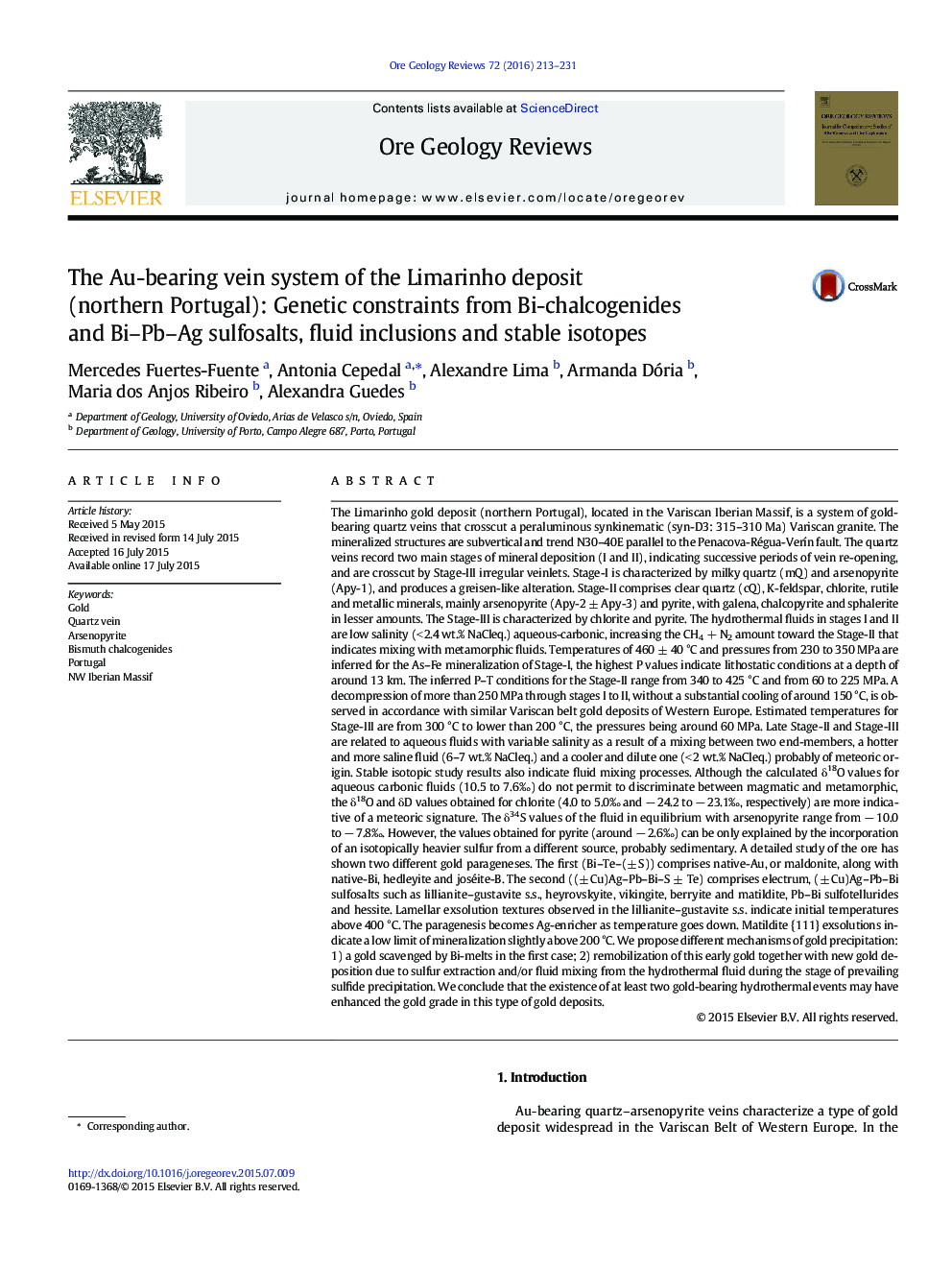| کد مقاله | کد نشریه | سال انتشار | مقاله انگلیسی | نسخه تمام متن |
|---|---|---|---|---|
| 6435732 | 1351852 | 2016 | 19 صفحه PDF | دانلود رایگان |

- We characterize three stages of mineralization in a gold-bearing quartz vein system.
- We establish composition and origin of the hydrothermal fluids involved.
- We identify two gold parageneses separated in time: Bi-Te ± S and (± Cu)-Ag-Pb-Bi-S ± Te.
- Au scavenged by Bi-melt and later remobilization together with new Au deposition
- Bi-Pb-Ag sulfosalts as tools to constrain gold deposition temperature
The Limarinho gold deposit (northern Portugal), located in the Variscan Iberian Massif, is a system of gold-bearing quartz veins that crosscut a peraluminous synkinematic (syn-D3: 315-310 Ma) Variscan granite. The mineralized structures are subvertical and trend N30-40E parallel to the Penacova-Régua-VerÃn fault. The quartz veins record two main stages of mineral deposition (I and II), indicating successive periods of vein re-opening, and are crosscut by Stage-III irregular veinlets. Stage-I is characterized by milky quartz (mQ) and arsenopyrite (Apy-1), and produces a greisen-like alteration. Stage-II comprises clear quartz (cQ), K-feldspar, chlorite, rutile and metallic minerals, mainly arsenopyrite (Apy-2 ± Apy-3) and pyrite, with galena, chalcopyrite and sphalerite in lesser amounts. The Stage-III is characterized by chlorite and pyrite. The hydrothermal fluids in stages I and II are low salinity (< 2.4 wt.% NaCleq.) aqueous-carbonic, increasing the CH4 + N2 amount toward the Stage-II that indicates mixing with metamorphic fluids. Temperatures of 460 ± 40 °C and pressures from 230 to 350 MPa are inferred for the As-Fe mineralization of Stage-I, the highest P values indicate lithostatic conditions at a depth of around 13 km. The inferred P-T conditions for the Stage-II range from 340 to 425 °C and from 60 to 225 MPa. A decompression of more than 250 MPa through stages I to II, without a substantial cooling of around 150 °C, is observed in accordance with similar Variscan belt gold deposits of Western Europe. Estimated temperatures for Stage-III are from 300 °C to lower than 200 °C, the pressures being around 60 MPa. Late Stage-II and Stage-III are related to aqueous fluids with variable salinity as a result of a mixing between two end-members, a hotter and more saline fluid (6-7 wt.% NaCleq.) and a cooler and dilute one (< 2 wt.% NaCleq.) probably of meteoric origin. Stable isotopic study results also indicate fluid mixing processes. Although the calculated δ18O values for aqueous carbonic fluids (10.5 to 7.6â°) do not permit to discriminate between magmatic and metamorphic, the δ18O and δD values obtained for chlorite (4.0 to 5.0â° and â 24.2 to â 23.1â°, respectively) are more indicative of a meteoric signature. The δ34S values of the fluid in equilibrium with arsenopyrite range from â 10.0 to â 7.8â°. However, the values obtained for pyrite (around â 2.6â°) can be only explained by the incorporation of an isotopically heavier sulfur from a different source, probably sedimentary. A detailed study of the ore has shown two different gold parageneses. The first (Bi-Te-(± S)) comprises native-Au, or maldonite, along with native-Bi, hedleyite and joséite-B. The second ((± Cu)Ag-Pb-Bi-S ± Te) comprises electrum, (± Cu)Ag-Pb-Bi sulfosalts such as lillianite-gustavite s.s., heyrovskyite, vikingite, berryite and matildite, Pb-Bi sulfotellurides and hessite. Lamellar exsolution textures observed in the lillianite-gustavite s.s. indicate initial temperatures above 400 °C. The paragenesis becomes Ag-enricher as temperature goes down. Matildite {111} exsolutions indicate a low limit of mineralization slightly above 200 °C. We propose different mechanisms of gold precipitation: 1) a gold scavenged by Bi-melts in the first case; 2) remobilization of this early gold together with new gold deposition due to sulfur extraction and/or fluid mixing from the hydrothermal fluid during the stage of prevailing sulfide precipitation. We conclude that the existence of at least two gold-bearing hydrothermal events may have enhanced the gold grade in this type of gold deposits.
Journal: Ore Geology Reviews - Volume 72, Part 1, January 2016, Pages 213-231